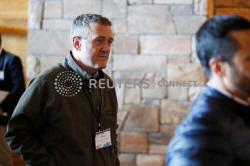The yield curve's still weird. Fed's Bullard is okay
with that
 Send a link to a friend
Send a link to a friend
 [January 17, 2020] ST.
LOUIS (Reuters) - It was more than a year ago when St. Louis Federal
Reserve bank President James Bullard started raising the alarm about a
U.S. bond market where interest rates seemed to show investors losing
faith in the economy, a risky environment for the Fed to carry out
planned rate increases. [January 17, 2020] ST.
LOUIS (Reuters) - It was more than a year ago when St. Louis Federal
Reserve bank President James Bullard started raising the alarm about a
U.S. bond market where interest rates seemed to show investors losing
faith in the economy, a risky environment for the Fed to carry out
planned rate increases.
As 2020 gets under way, the closely watched spreads between long- and
short-term Treasury securities still don't look completely healthy.
But with months of market turbulence and three rate cuts now in the rear
view mirror, Bullard says he is ready to stand down, leave policy on
hold for up to a year, and see what transpires.
"We eased substantially in 2019. That will come on board in 2020," just
as the United States and China also signal an easing of trade tensions
with the Wednesday signing of a preliminary agreement, Bullard said in a
Reuters interview. "We will see how much impact we have in the first
half of 2020 and probably all the way through 2020, and then we will see
where we are.
That's a shift for Bullard from what had been aggressive stumping,
beginning as far back as late 2017, for the Fed to beware of raising
interest rates too much, in part because of the behavior of the bond
market.

But it is also further indication of a broader consensus that may well
keep the Fed on the sidelines, with interest rates unchanged, throughout
a potentially turbulent U.S. presidential election season.
The last year was a rocky one for the Fed, with markets upended by a
global trade war, the central bank the target of verbal attacks by
President Donald Trump, and policymakers divided on what the economy
needed. Over the year there were dissents against the Fed's
quarter-point rate cuts coming from those who believed policy should be
even easier and those who thought the opposite.
Bullard dissented twice in favor of deeper and faster cuts.
As the year ended, Fed officials across the spectrum agreed they could
pause any further rate moves until something in the economy changes.
For those like Bullard who might have wanted even lower rates, it's an
acknowledgement the economy is still absorbing the massive shift toward
looser monetary policy that the Fed engineered last year when it lowered
the overnight policy rate to its current range of between 1.5% and
1.75%. For those who might have once been concerned about inflation or
financial risks it's an acknowledgement that as of now there's little
evidence of either.
NOT THE SAME OLD SONG
If 2019 had a theme, Bullard said, it was of the Fed fully coming to
terms with the fact that low unemployment, low inflation, low interest
rates, and a seemingly stable financial system can coexist. In standard
theory they often conflict, with low unemployment sparking higher
inflation. At this point, even the committee's most ardent inflation
"hawks" see last year's rate cuts as a potential adjustment to that new
world - a "reset," as Kansas City Fed President Esther George called it
Tuesday. She dissented against all three rate cuts last year on the view
rates were low enough.
[to top of second column] |

James Bullard, President of the Federal Reserve Bank of St. Louis,
leaves the three-day "Challenges for Monetary Policy" conference in
Jackson Hole, Wyoming, U.S., August 23, 2019. REUTERS/Jonathan
Crosby

Neither Bullard nor George vote on policy this year.
It was a year where we really came to grips with the idea that we were
not going to go to 1990s or 2000 level interest rates in the United
States," Bullard said. "Not only did we quit trying...but we turned
around and went the other way.
It has been a longstanding debate, but since last fall policymakers have
marked down their estimates of the underlying long-run "neutral" rate of
interest to around half a percentage point, once accounting for
inflation. Bullard thinks it is more like zero, but the point is made:
the world's different than when inflation-adjusted rates of 2% to 3%
were the norm.
So is the United States in the clear?
Bullard says he now thinks 2020 could hold positive surprises as
businesses finish readjusting to a less predictable trade environment,
and start rolling out new strategies, methods and supply chains to cope.
A tight labor market, he feels, could prompt capital investment that
improves productivity.
And if trade uncertainty lifts, the United States "might grow faster
than 2019, and it is that kind of dynamic that would lead us back to a
better expected inflation environment, that meets or exceeds the Fed's
2% inflation target.
He hasn't turned his back on the yield curve. The roughly quarter
percentage point spread between 10- and 2-year Treasuries is well below
what it was in the 1990s, say, during another extended era of growth.
Bullard said he'd rest easier if it climbed to at least half a percent,
signaling stronger market faith in growth and inflation.


But that's no reason to argue for more rate cuts now, he said.
"We are going in the right direction."
(Reporting by Howard Schneider; Editing by Andrea Ricci)
[© 2020 Thomson Reuters. All rights
reserved.] Copyright 2020 Reuters. All rights reserved. This material may not be published,
broadcast, rewritten or redistributed.
Thompson Reuters is solely responsible for this content. |